For about four years, Sony and Honda have been teasing an electric and autonomous car. Last year the project got a name, Afeela. Entry into an already crowded marketplace with a new and new-agey-sounding name is a steep hill to climb, but the joint venture thinks it can break through by bringing a new suite of “experiences” to the automotive space.
We recently got the chance to take our closest look yet at an Afeela prototype, one in such early stages that we weren’t allowed to open the hood, trunk, or even the center console under-armrest storage compartment. We couldn’t drive it either, but were able to better understand the direction Afeela plans to take on-board technology and entertainment.
The first thing noticed is that the Afeela blends into the background, even in an otherwise largely empty showroom. This is by design. Its shape is clean and decidedly un-aggressive, uncluttered by the swoops and surfacing that characterize many modern designs. That’s because the Afeela was made to let the owner’s personality take center stage via many customization options.

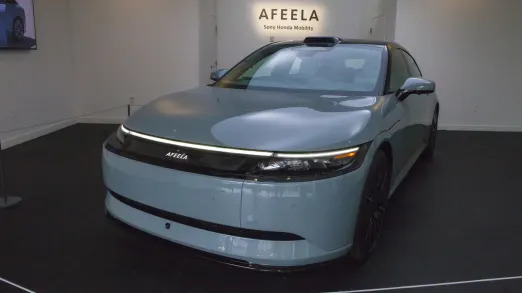
The average person would be hard pressed to know that two of the biggest brand names in the world are behind the tranquil, river pebble shape. Neither Sony nor Honda have put their stamps on the car. Indeed, a representative told us repeatedly that Sony Honda Mobility is its own thing, 50/50 from each but not Sony or Honda. When asked if Honda and GM’s now-scrapped partnership to build EVs influenced the car, the representative reiterated that Sony Honda Mobility is its own entity and Afeela is the brand. The name appears once in the taillight bar and can, if the driver chooses, also appear on a screen where a traditional grille would be.
That sliver of pixels is called the Media Bar, and can be customized to display a range of information. It reacts as you approach the car and can show, for example, how much battery charge is left, a pre-programmed theme matching the interior (more on that in a bit), or a personalized message. On the day we saw the car it greeted each visiting guest with their name in the welcome message. Presumably there will be a filter for profanities or distasteful images, but SHM admit they haven’t worked that part out yet.
The car also has no physical door handles, just a button by the base of the window. Doors open via a proximity fob, phone app, or facial recognition via a camera in the B-pillar. When asked what happens if there is no power, the representative reminded us that this is an early prototype and SHM will address such concerns before the car goes into production.

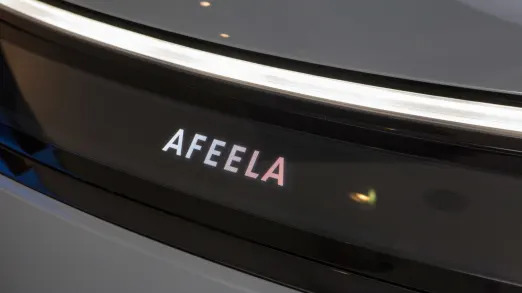
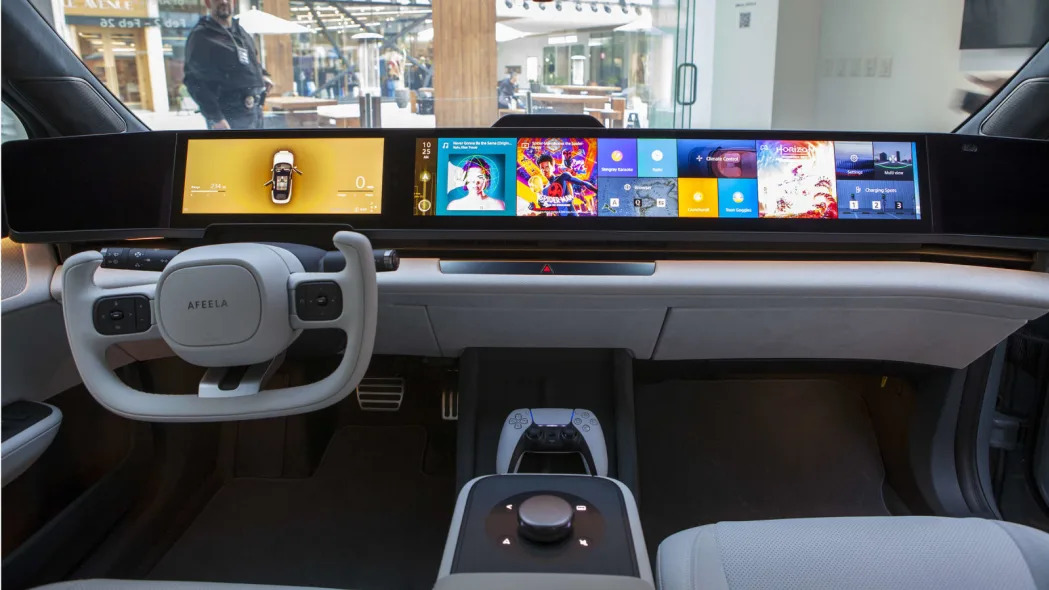
The cabin looks like that of a modern concept car. A panoramic touchscreen spans the width of the dashboard, visible at all times due to the steering yoke. Thankfully, the Afeela does still have physical stalks, wipers on the left and a gear selector on the right. Two fairly standard-looking four-directional buttons for functions like volume, track seek and vehicle information are located on the yoke’s spokes.
Physical climate control buttons reside under the center of the panoramic screen, and the center console has a Mazda-style dial and four satellite buttons, but we weren’t allowed to play with that. Everything is also controllable on the main touchscreen. On either end of the panoramic screen are two smaller ones that act as digital side mirrors. The Afeela has physical side mirrors on the outside as well, because relying solely on digital ones is illegal in the United States.
The party trick here is the Afeela’s infotainment interface. The panoramic touchscreen consists of one sweeping surface but is functionally divided into thirds. One sits before the driver and displays vehicle info, maps, etc. The middle and right sections are where the entertainment functions happen, and sections can be swapped with the flick of a finger.
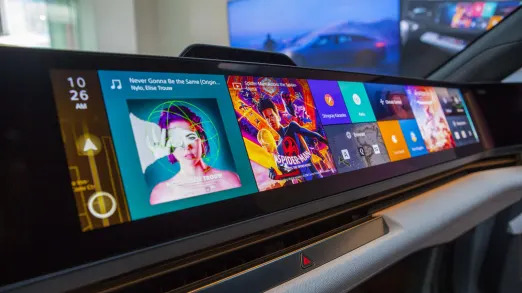
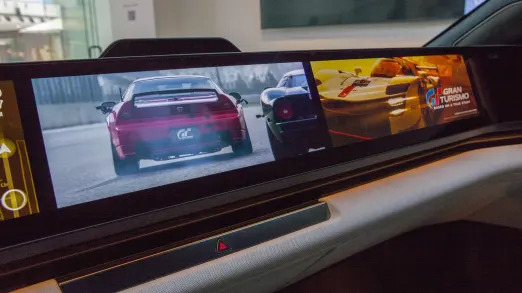
From a collage of app tiles similar to a Netflix menu, one can select digital amusements like movies, video games, even karaoke. And to answer the million dollar question, you can indeed play Sony PlayStation games in the car. There’s no actual console on board, but by connecting a PS4 or PS5 remotely, gamers can stop a game at home and pick up where they left off in the car via an in-car controller.
Customization options can be mapped to individual driver profiles, but Afeela also comes pre-programmed with “themes” based on Sony properties. If a superhero fan chooses Spider-Man, red and blue lighting and a web motif is displayed on screens, including the external Media Bar. Gran Turismo players can evoke a racing theme where the Afeela’s engine-mimicking and pedestrian warning sounds impersonate a virtual Le Mans racer.
When the Afeela starts to move, any movies or karaoke lyrics or game screens automatically move to the right side so as to not draw attention from the driver. However, contained in Afeela’s plan is Level 3 autonomous driving, where the car can drive itself in certain situations, but doesn’t require constant driver vigilance. The representative was quick to mention the 800 TOPS (Trillions of Operations Per Second) machine-learning AI the car will employ, for safety and recognition of vehicles and pedestrians, and adaptation to night or bad weather conditions. We wouldn't be surprised if such a production system would be initially only usable in very specific conditions.
Two additional screens each about the size of a laptop screen are attached to each seatback for rear passengers. They can be synced so all riders can have the same experience, or each one can do their own thing. Sound is projected via an array of speakers, some located in the seats, as part of Sony’s immersive 360 Reality Audio system. Music and sounds can feel like they’re coming from any direction, and the representative told us that each occupant will be able to enjoy their own media.
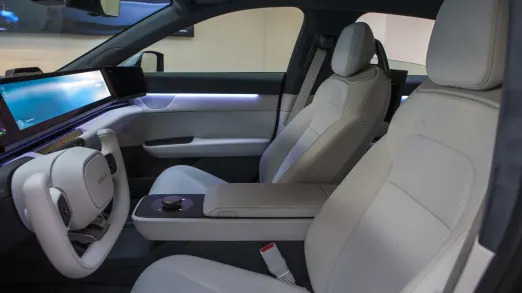
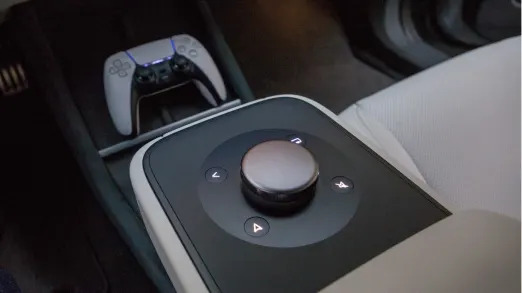
When not doubling as a rolling theater, wide maps projected onto the prodigious screen real estate can be easily manipulated with pinch-to-zoom and seamless 2D-to-3D rotation. Occupants can call up views from the Afeela’s many external cameras as well. Afeela will also have an app store where developers can create their own programs compatible with the car. This raises questions about security, but we were told that they are taking it seriously.
There are internal cameras as well to scan for driver alertness, but Sony Honda Mobility would not disclose the number of cameras, sensors, or speakers in the car. From what we could discern visually, a charging port exists on either side’s front fender and the prototype sat on 245/40-R21 Pirelli P-Zeros. SHM wouldn’t say anything about the power, battery capacity, range, charging port type or pricing. The representative only said that the car would be AWD, and that they’ll be taking pre-orders next year with deliveries starting in 2026.
We’ve been promised various interpretations of the mobile living room for a decade. Afeela might be the closest vehicle yet to achieving it, even if still years away from production with changes certain to be made. At the very least, the infotainment system looks like it can be put into production without much fuss.
We like that Afeela’s EV ethos is providing fun rather than trying desperately to be edgy and cool, but we’re not convinced that it’s breaking enough new ground to anchor a brand-new, uh, brand. If you'll allow us a moment of pure speculation, perhaps one reason for the separate brand is that Honda wants to retain its historically excellent sporty driving feel in an age of electrification. Afeela’s focus, on the other hand, seems squarely situated on digital dopamine hits, not dynamics.
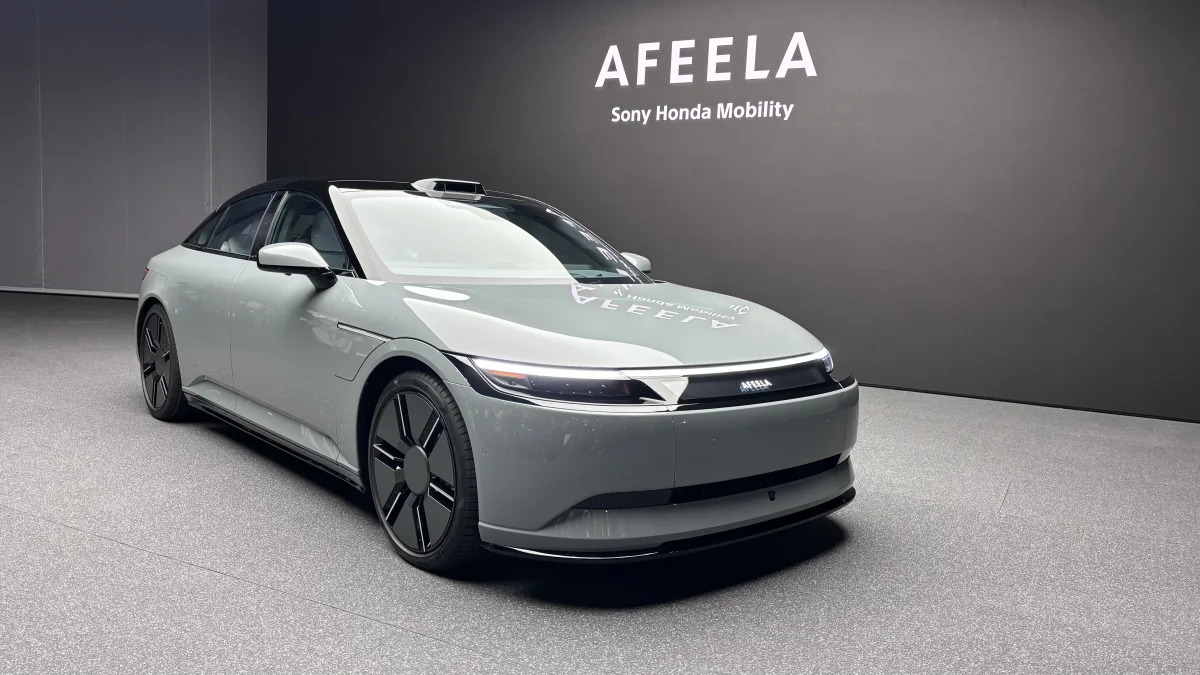









Sign in to post
Please sign in to leave a comment.
Continue